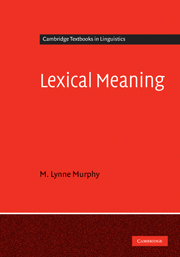Book contents
- Frontmatter
- Contents
- List of figures
- Preface: using this book
- Acknowledgments
- Typographical conventions
- Part I Meaning and the lexicon
- Part II Relations among words and senses
- Part III Word classes and semantic types
- 7 Ontological categories and word classes
- 8 Nouns and countability
- 9 Predication: verbs, events, and states
- 10 Verbs and time
- 11 Adjectives and properties
- References
- Index
11 - Adjectives and properties
from Part III - Word classes and semantic types
Published online by Cambridge University Press: 05 June 2012
- Frontmatter
- Contents
- List of figures
- Preface: using this book
- Acknowledgments
- Typographical conventions
- Part I Meaning and the lexicon
- Part II Relations among words and senses
- Part III Word classes and semantic types
- 7 Ontological categories and word classes
- 8 Nouns and countability
- 9 Predication: verbs, events, and states
- 10 Verbs and time
- 11 Adjectives and properties
- References
- Index
Summary
Key words:
selectional binding, gradable/non-gradable, scale, scalar/non-scalar, absolute/relative, dimension, intensifier, positive/equative/comparative/superlative, standard of comparison, neutral range, open/closed scale, neutralization
Overview
As discussed in chapter 7, adjectives typically denote properties, many of which are gradable. In this chapter, we examine types of gradable and non-gradable adjectives and go into some detail about the use of dimensional scales (introduced in §6.2.4) to represent adjective meaning. We'll see how such scales can help to clarify aspects of the interpretation of gradable adjectives (e.g. why a deep ocean is deeper than a deep bowl) and the neutralization of some adjectives in some contexts (i.e. why we can say a child is six years old without committing ourselves to the proposition that the child is old). Before exploring these issues, we look at another source of variability in adjective meaning – why, for example, a good knife is sharp, but a good chair is not.
- Type
- Chapter
- Information
- Lexical Meaning , pp. 222 - 242Publisher: Cambridge University PressPrint publication year: 2010

